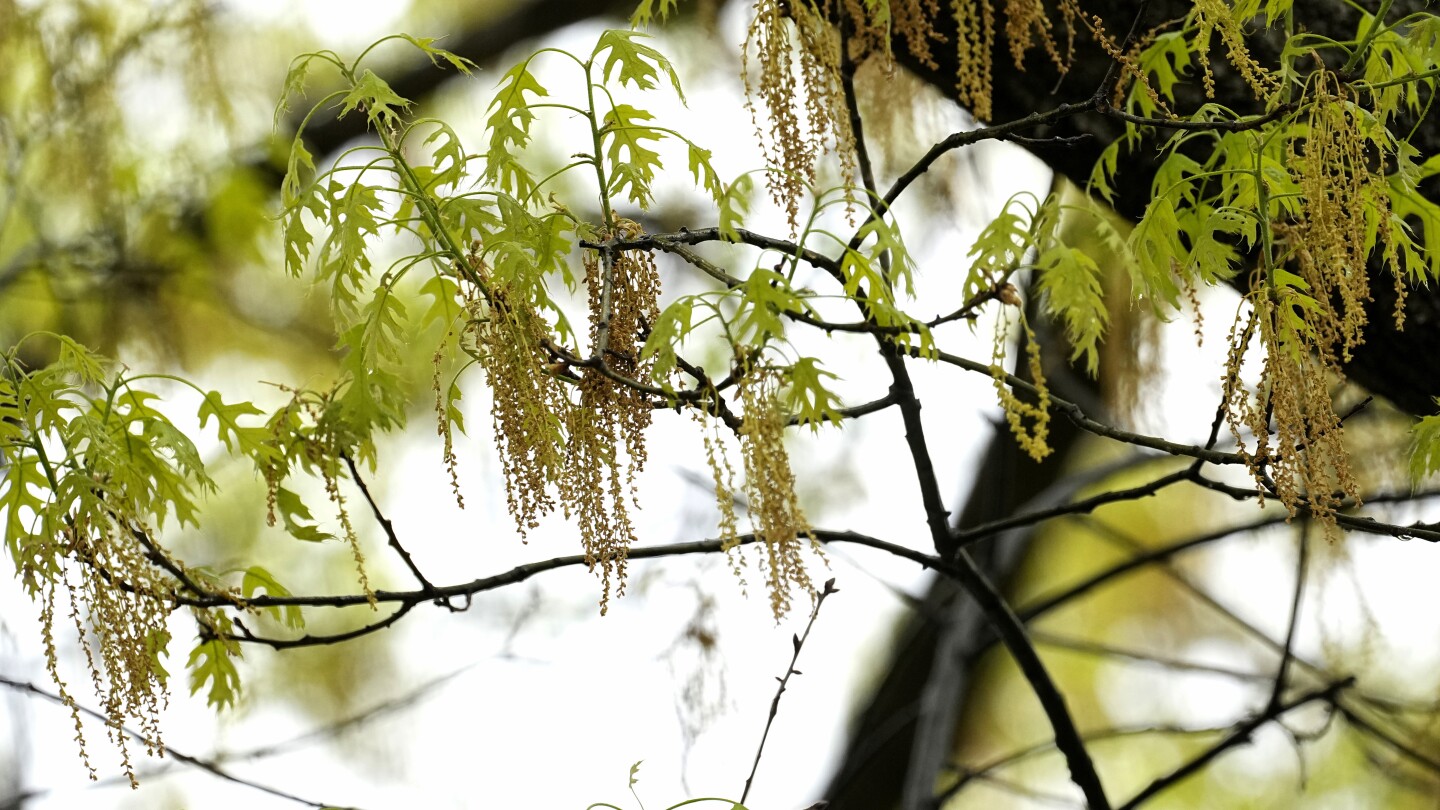Lifestyle
‘Danish Viking blood is boiling.’ Danes boycott US goods with fervor as others in Europe do so too

Ivan Hansen, a retired Danish police officer, loaded up his basket at the supermarket, carefully checking each product to avoid buying anything made in the United States. No more Coca-Cola, no more California Zinfandel wine or almonds.
The 67-year-old said it’s the only way he knows to protest U.S. President Donald Trump’s policies. He’s furious about Trump’s threat to seize the Danish territory of Greenland, but it’s not just that. There are also the threats to take control of the Panama Canal and Gaza. And Trump’s relationship with Elon Musk, who has far-right ties and made what many interpreted as a straight-armed Nazi salute.
On his recent shopping trip, Hansen returned home with dates from Iran. It shocked him to realize that he now perceives the United States as a greater threat than Iran.
“Trump really looks like a bully who tries in every way to intimidate, threaten others to get his way,” he told The Associated Press. “I will fight against that kind of thing.”
A sign in Bilka supermarket in Randers, Denmark, reads: ”Now it’s star-clear whether the label is European. The choice is yours, but we’ve made it easier for you to shop European: Look for the star on the price tag to see if the label is owned by a company in Europe. And don’t worry, we still have plenty of labels from the rest of the world.’’, Monday, March 17, 2025. (Bo Amstrup/Ritzau Scanpix via AP)
A growing boycott movement across Europe
Hansen is just one supporter of a growing movement across Europe and Canada to boycott U.S. products. People are joining Facebook groups where they exchange ideas about how to avoid U.S. products and find alternatives. Feelings are especially strong across the Nordic region — and very possibly strongest in Denmark given Trump’s threats to seize Greenland.
Google trends showed a spike in searches for the term “Boycott USA,” and “Boycott America,” as Trump announced new tariffs, with the top regions including Denmark, Canada and France. At the same time, a global backslash is also building against Tesla as the brand becomes tied to Trump, with plunging sales in Europe and Canada. In Germany, police were investigating after four Teslas were set on fire Friday.
Elsebeth Pedersen, who lives in Faaborg on the Danish island of Funen, just bought a car and made a point of not even looking at U.S.-made options.
“Before Elon Musk started to act like a maniac a Tesla could have been an option. And maybe a Ford,” she said.
French entrepreneur Romain Roy said his solar panel firm has bought a new Tesla fleet each year since 2021 but canceled its order for another 15 to take a stand against Musk’s and Trump’s policies.
Describing the United States as “a country closing in on itself,” he cited Trump’s withdrawal from the Paris climate accord and Musk’s arm gestures. He said he was instead buying European models, even though it would cost an additional 150,000 euros ($164,000).
“Individual consumers, society, our countries, Europe must react,” he told broadcaster Sud Radio.
Responding to consumer demand, Denmark’s largest supermarket chain, the Salling Group, created a star-shaped label this month to mark European-made goods sold in its stores. CEO Anders Hagh said it’s not a boycott, but a response to consumers demanding a way to easily avoid American products.
“Our stores will continue to have brands on the shelves from all over the world, and it will always be up to customers to choose. The new label is only an additional service for customers who want to buy goods with European labels,” he said in a LinkedIn post.
BBQ products with and without the star mark in Bilka in Randers, Denmark, making it easier for customers to buy European goods, Monday, March 17, 2025. (Bo Amstrup/Ritzau Scanpix via AP)
‘I have never seen Danes so upset’
For Bo Albertus, “when Trump went on television and said he would by political force or military force take a piece of the Danish kingdom, it was just too much for me.”
The 57-year-old said he felt powerless and had to do something. He has given up Pepsi, Colgate toothpaste, Heinz ketchup and California wine, and replaced them with European products.
He is now an administrator of the Danish Facebook page “Boykot varer fra USA” (Boycott goods from the U.S.), which has swelled to over 80,000 members.
“Drink more champagne,” one user posted after Trump threatened 200% tariffs on EU wine and Champagne.
Albertus, a school principal, told the AP he really misses the strong taste of Colgate. But he’s been pleasantly surprised at finding a cola replacement that is half the price of Pepsi.
Trump’s policies have “brought the Danish Viking blood boiling,” said Jens Olsen, an electrician and carpenter. He is now considering replacing $10,000 worth of U.S.-made DeWalt power tools even though it will cost him a lot.
He has already found European replacements for an American popcorn brand and California-made Lagunitas IPA beer, which he calls “the best in the world.”
“I’ve visited the brewery several times, but now I don’t buy it anymore,” he said. He has mixed feelings because he is a dual Danish-U.S. citizen, and has spent a lot of time in the United States. But he can’t contain his anger.
“I’m 66 years old and I have never seen the Danes so upset before,” he said.
Michael Ramgil Stæhr has canceled a fall trip to the U.S. and is among many choosing to buy Danish instead of American-made, though he cannot pinpoint the exact moment he made the decision.
“Maybe it was when (Trump) announced to the world press that he intended to ‘take’ Greenland and the Panama Canal, and if necessary by military force. That and the gangster-like behavior towards the Ukrainian president in the White House,” the 53-year-old Copenhagen resident said.
“The man is deadly dangerous and is already costing lives” in the developing world and Ukraine, added Stæhr, who works helping disabled war veterans, many of whom got injured serving alongside U.S. troops in the Balkans, Iraq and Afghanistan. He himself served in Bosnia.
Rising anger in France, too
Edouard Roussez, a farmer from northern France, launched an online group, “Boycott USA, Buy French and European!” that in just two weeks has attracted over 20,000 members on Facebook.
Roussez believes a boycott of U.S. companies is a good way to express opposition to Trump’s policies, especially “the commercial and ideological war” he believes Trump is waging against Europe.
“First of all, these are the companies that financed Donald Trump’s campaign,” he said on state-owned LCP television channel. “I’m thinking of Airbnb, I’m thinking of Uber, I’m thinking of Tesla of course.”
The irony of it all? The group is on Facebook. Roussez said only the American online social media platform gave him the reach he needed. But he’s working to migrate the group to other platforms with no U.S. funding or capital.
A star-labeled price tag for snacks in Bilka in Randers, Denmark, making it easier for customers to buy European goods, Monday, March 17, 2025. (Bo Amstrup/Ritzau Scanpix via AP)
As for any impact on U.S. export profits or policymaking, that’s unlikely, said Olof Johansson Stenman, a professor of economics at the University of Gothenburg.
The boycott could have a psychological effect on Americans who see the scale of anger, but “some may also say, ‘We don’t like these Europeans anyway,’” Stenman said.
Some choices are harder than others
Simon Madsen, 54, who lives in the Danish city of Horsens with his wife and 13-year-old twins, says the family has given up Pringles, Oreos and Pepsi Max. Not so hard, really.
But now they’re discussing doing without Netflix, and that is a step too far for the kids.
He also wonders whether he should keep buying Danish-made Anthon Berg chocolate marzipan bars, which are made with American almonds.
It’s important, he said, for people to use the power of the purse to pressure companies to change.
“It’s the only weapon we’ve got,” he said.
____
AP writers Stefanie Dazio in Berlin, John Leicester and Samuel Petrequin in Paris, and Laurie Kellman in London contributed.
Lifestyle
Zimbabwe’s stone carvers seek a revival as an Oxford exhibition confronts a British colonial legacy

CHITUNGWIZA, Zimbabwe (AP) — A pair of white hands blinding a Black face. A smiling colonizer with a Bible, crushing the skull of a screaming native with his boot. Chained men in gold mines, and a pregnant woman.
These stone sculptures from Zimbabwe will take center stage at an upcoming exhibition at Oxford University in Britain, aiming to “contextualize” the legacy of British imperialist Cecil John Rhodes with depictions of religious deception, forced labor and sexual abuse.
Rhodes conquered large parts of southern Africa in the late 19th century. He made a fortune in gold and diamond mining and grabbed land from the local population. His grave lies under a slab of stone atop a hill in Zimbabwe.
Oxford’s Oriel College, where the exhibition will be held in September, is a symbolic setting. A statue of Rhodes stands there despite protests against it since 2015. Rhodes, who died in 1902, was an Oriel student who left 100,000 pounds (now valued at about 10.5 million pounds, or $13.5 million) to the school. His influence endures through a scholarship for students from southern African countries.
For Zimbabwean stone carvers at Chitungwiza Arts Center near the capital, Harare, the exhibition is more than an opportunity for Western audiences to glimpse a dark history. It is also a chance to revive an ancient but struggling art form.
Stone sculpture, once a thriving local industry, has suffered due to vast economic challenges and declining tourism.
“This will boost business. Buyers abroad will now see our work and buy directly from the artists,” said sculptor Wallace Mkanka. His piece, depicting the blinded Black face, was selected as the best of 110 entries and will be one of four winning sculptures on display at Oxford.
Zimbabwe, meaning “House of Stone,” derives its identity from the Great Zimbabwe ruins, a 1,800-acre Iron Age city built with precision-cut stones delicately stacked without mortar. It is a UNESCO World heritage site.
The southern African country has long used stone sculpture as a form of storytelling to immortalize history. The craft survived close to a century of colonial rule that sought to erase local traditions, religion and art forms.
It thrived internationally instead. Thousands of pieces were plundered from Africa. Some later became subjects of repatriation campaigns. Others became prized by tourists and collectors. A permanent collection of 20 Zimbabwean stone sculptures is displayed in a pedestrian tunnel at Hartsfield-Jackson Atlanta International Airport, one of the world’s busiest.
At its peak following independence, Zimbabwe’s stone sculpture industry thrived, with local white farmers purchasing pieces for their homes and facilitating international sales.
“Customers were everywhere. They would pay up front, and I always had a queue of clients,” recalled Tafadzwa Tandi, a 45-year-old sculptor whose work will feature in the Oxford exhibition.
However, the industry has struggled over the past two decades.
Zimbabwe’s global image suffered after controversial land reforms more than two decades ago displaced over 4,000 white farmers to redistribute land to about 300,000 Black families, according to government figures. Late ruler Robert Mugabe defended the reforms as necessary to address colonial-era inequities, but they had unintended economic consequences.
“Many of our customers were friends of the farmers. That is where the problem originated from,” said Tendai Gwaravaza, chairman of Chitungwiza Arts Center.
At the center, the sound of grinders filled the air as sculptors carved. Hundreds of finished pieces, ranging from small carvings to life-sized sculptures, waited for buyers.
“The only solution now is to get out there to the markets ourselves. If we don’t, no one will,” Gwaravaza said.
The Oxford exhibition represents such an opportunity for exposure, he said.
It is the brainchild of the Oxford Zimbabwe Arts Partnership, formed in response to the “Rhodes Must Fall” campaign during the Black Lives Matter protests in the U.S.
The group, consisting of Zimbabwean artists, an Oxford alumnus and a professor of African history, initially envisioned a larger project titled “Oxford and Rhodes: Past, Present, and Future.” It included enclosing Rhodes’ statue in glass, installing 100 life-size bronze statues of African liberation fighters and creating a collaborative sculpture using recycled materials to represent the future.
However, the project required an estimated 200,000 pounds, far beyond available resources. Eventually, Oriel College provided 10,000 pounds for a scaled-down exhibition.
“It’s still my hope that one day it could happen, but for now we have just accepted something very small to make a start and to do something,” said Richard Pantlin, the Oxford alumnus and OZAP co-founder.
___
For more on Africa and development: https://apnews.com/hub/africa-pulse
___
The Associated Press receives financial support for global health and development coverage in Africa from the Gates Foundation. The AP is solely responsible for all content. Find AP’s standards for working with philanthropies, a list of supporters and funded coverage areas at AP.org.
Lifestyle
Allergy season: How to check pollen levels and alleviate symptoms

ATLANTA (AP) — Allergy season can be miserable for tens of millions of Americans when trees, grass, and other pollens cause runny noses, itchy eyes, coughing and sneezing.
Where you live, what you’re allergic to and your lifestyle can make a big difference when it comes to the severity of your allergies. Experts say climate change is leading to longer and more intense allergy seasons, but also point out that treatments for seasonal allergies have become more effective over the last decade.
Here are some tips from experts to keep allergy symptoms at bay — maybe even enough to allow you to enjoy the outdoors.
Where are pollen levels the worst this year?
The Asthma and Allergy Foundation of America issues an annual ranking of the most challenging cities to live in if you have allergies, based on over-the-counter medicine use, pollen counts and the number of available allergy specialists.
This year, the top five cities are: Wichita, Kansas; New Orleans; Oklahoma City; Tulsa, Oklahoma; and Memphis.
Which pollens cause allergies?
There are three main types of pollen. Earlier in the spring, tree pollen is the main culprit. After that grasses pollinate, followed by weeds in the late summer and early fall.
Some of the most common tree pollens that cause allergies include birch, cedar, cottonwood, maple, elm, oak and walnut, according to the Asthma and Allergy Foundation of America. Grasses that cause symptoms include Bermuda, Johnson, rye and Kentucky bluegrass.
This article is part of AP’s Be Well coverage, focusing on wellness, fitness, diet and mental health. Read more Be Well.
How do I track pollen levels?
Pollen trackers can help you decide when to go outside. The American Academy of Allergy Asthma and Immunology tracks levels through a network of counting stations across the U.S. Counts are available at its website and via email.
Limit your exposure to pollens
The best and first step to controlling allergies is avoiding exposure. Keep the windows in your car and your home closed, even when it’s nice outside.
If you go outside, wearing long sleeves can keep pollen off your skin to help ward off allergic reactions, said Dr. James Baker, an allergist at the University of Michigan. It also provides some sun protection, he added.
When you get home, change your clothes and shower daily to ensure all the pollen is off of you — including your hair. If you can’t wash your hair every day, try covering it when you go outside with a hat or scarf. Don’t get in the bed with your outside clothes on, because the pollen will follow.
It’s also useful to rinse your eyes and nose with saline to remove any pollen, experts said. And the same masks that got us through the pandemic can protect you from allergies — though they won’t help with eye symptoms.
How to relieve allergy symptoms
Over-the-counter nasal sprays are among the most effective treatments for seasonal allergies, experts said.
But the vast majority of patients use them incorrectly, irritating parts of the nose, said Dr. Kathleen Mays, an allergist at Augusta University in Georgia. She suggested angling the nozzle outward toward your ear rather than sticking it straight up your nose.
Over-the-counter allergy pills like Claritin, Allegra and Zyrtec are helpful, but may not be as effective as quickly since they’re taken by mouth, experts said.
Experts also said that if your allergy symptoms are impacting your quality of life, like causing you to lose sleep or a lack focus at work or school, it might be time to consider an allergist appointment for immunotherapies.
Some remedies for allergy relief that have been circulating on social media or suggested by celebrities — like incorporating local honey into your diet to expose yourself to pollen — have been debunked.
Dr. Shayam Joshi, an allergist at Oregon Health and Science University, said that’s because the flowers that bees pollinate typically don’t contain the airborne pollen that causes allergy symptoms.
Is allergy season changing?
With climate change, winters are milder and growing seasons are longer, meaning there’s more opportunity for pollen to stay in the air, resulting in longer and more severe allergy seasons.
In many areas across the country, pollen counts have broken decades of records. In late March, the Atlanta Allergy and Asthma Center measured a pollen count of over 14,000 grains per cubic meter, which is considered extremely high.
___
The Associated Press Health and Science Department receives support from the Howard Hughes Medical Institute’s Science and Educational Media Group and the Robert Wood Johnson Foundation. The AP is solely responsible for all content.
Lifestyle
The 250th anniversary of the Battles of Lexington and Concord opens debate over US independence
NEW YORK (AP) — The American Revolution began 250 years ago, in a blast of gunshot and a trail of colonial spin.
Starting with Saturday’s anniversary of the Battles of Lexington and Concord, the country will look back to its war of independence and ask where its legacy stands today.
The semiquincentennial comes as President Donald Trump, the scholarly community and others divide over whether to have a yearlong party leading up to July 4, 2026, as Trump has called for, or to balance any celebrations with questions about women, the enslaved and Indigenous people and what their stories reveal.
The history of Lexington and Concord in Massachusetts is half-known, the myth deeply rooted.
What exactly happened at Lexington and Concord?
Reenactors may with confidence tell us that hundreds of British troops marched from Boston in the early morning of April 19, 1775, and gathered about 14 miles (22.5 kilometers) northwest on Lexington’s town green.
Firsthand witnesses remembered some British officers yelled, “Thrown down your arms, ye villains, ye rebels!” and that amid the chaos a shot was heard, followed by “scattered fire” from the British. The battle turned so fierce that the area reeked of burning powder. By day’s end, the fighting had continued around 7 miles (11 kilometers) west to Concord and some 250 British and 95 colonists were killed or wounded.
But no one has learned who fired first, or why. And the revolution itself was initially less a revolution than a demand for better terms.
Woody Holton, a professor of early American history at the University of South Carolina, says most scholars agree the rebels of April 1775 weren’t looking to leave the empire, but to repair their relationship with King George III and go back to the days preceding the Stamp Act, the Tea Act and other disputes of the previous decade.
“The colonists only wanted to turn back the clock to 1763,” he said.
Stacy Schiff, a Pulitzer Prize winning historian whose books include biographies of Benjamin Franklin and Samuel Adams, said Lexington and Concord “galvanized opinion precisely as the Massachusetts men hoped it would, though still it would be a long road to a vote for independence, which Adams felt should have been declared on 20 April 1775.”
But at the time, Schiff added, “It did not seem possible that a mother country and her colony had actually come to blows.”
A fight for the ages
The rebels had already believed their cause greater than a disagreement between subjects and rulers. Well before the turning points of 1776, before the Declaration of Independence or Thomas Paine’s boast that “We have it in our power to begin the world over again,” they cast themselves in a drama for the ages.
The so-called Suffolk Resolves of 1774, drafted by civic leaders of Suffolk County, Massachusetts, prayed for a life “unfettered by power, unclogged with shackles,” a fight that would determine the “fate of this new world, and of unborn millions.”
The revolution was an ongoing story of surprise and improvisation. Military historian Rick Atkinson, whose “The Fate of the Day” is the second of a planned trilogy on the war, called Lexington and Concord “a clear win for the home team,” if only because the British hadn’t expected such impassioned resistance from the colony’s militia.
The British, ever underestimating those whom King George regarded as a “deluded and unhappy multitude,” would be knocked back again when the rebels promptly framed and transmitted a narrative blaming the royal forces.
“Once shots were fired in Lexington, Samuel Adams and Joseph Warren did all in their power to collect statements from witnesses and to circulate them quickly; it was essential that the colonies, and the world, understand who had fired first,” Schiff said. “Adams was convinced that the Lexington skirmish would be ‘famed in the history of this country.’ He knocked himself out to make clear who the aggressors had been.”
A country still in progress
Neither side imagined a war lasting eight years, or had confidence in what kind of country would be born out of it. The founders united in their quest for self-government but differed how to actually govern, and whether self-government could even last.
Americans have never stopped debating the balance of powers, the rules of enfranchisement or how widely to apply the exhortation, “All men are created equal.”
“I think it’s important to remember that the language of the founders was aspirational. The idea that it was self-evident all men were created equal was preposterous at a time when hundreds of thousands were enslaved,” said Atkinson, who cites the 20th-century poet Archibald MacLeish’s contention that “democracy is never a thing done.”
“I don’t think the founders had any sense of a country that some day would have 330 million people,” Atkinson said. “Our country is an unfinished project and likely always will be.”
-

 Education2 days ago
Education2 days agoHarvard’s battle with the Trump administration is creating a thorny financial situation
-

 Sports2 days ago
Sports2 days agoAaron Rodgers ‘not holding anybody hostage’ as he decides his future, retirement a possibility
-

 Europe2 days ago
Europe2 days agoLive updates: Trump news, Ukraine peace talks, US immigration, tariffs and university funding
-

 Conflict Zones1 day ago
Conflict Zones1 day agoTrump says US may ‘pass’ on helping end war if Russia, Ukraine resist deal | Russia-Ukraine war News
-

 Conflict Zones1 day ago
Conflict Zones1 day ago‘How do I live like this?’ asks Gaza boy who lost arms in Israeli attack | Gaza News
-

 Europe1 day ago
Europe1 day agoThe Trump administration says Europe is taking advantage of the US. That’s not exactly true
-

 Europe2 days ago
Europe2 days agoTrump’s ‘lone ranger’: How Steve Witkoff became the defacto point man on America’s foreign policy challenges
-

 Lifestyle2 days ago
Lifestyle2 days agoSweets from the sky! A helicopter marshmallow drop thrills kids in suburban Detroit




